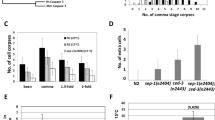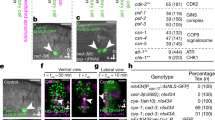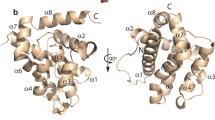Abstract
Genetic studies have identified over a dozen genes that function in programmed cell death (apoptosis) in the nematode Caenorhabditis elegans1,2,3. Although the ultimate effects on cell survival or engulfment of mutations in each cell death gene have been extensively described, much less is known about how these mutations affect the kinetics of death and engulfment, or the interactions between these two processes. We have used four-dimensional-Nomarski time-lapse video microscopy to follow in detail how cell death genes regulate the extent and kinetics of apoptotic cell death and removal in the early C. elegans embryo. Here we show that blocking engulfment enhances cell survival when cells are subjected to weak pro-apoptotic signals. Thus, genes that mediate corpse removal can also function to actively kill cells.
This is a preview of subscription content, access via your institution
Access options
Subscribe to this journal
Receive 51 print issues and online access
$199.00 per year
only $3.90 per issue
Buy this article
- Purchase on Springer Link
- Instant access to full article PDF
Prices may be subject to local taxes which are calculated during checkout




Similar content being viewed by others
References
Metzstein, M. M., Stanfield, G. M. & Horvitz, H. R. Genetics of programmed cell death in C. elegans: past, present and future. Trends Genet. 14, 410–416 (1998).
Hengartner, M. O. in C. elegans II (eds Riddle, D. L., Blumenthal, T., Meyer, B. J. & Priess, J. R.) 383–415 (Cold Spring Harbor Laboratory, Cold Spring Harbor, 1997).
Gumienny, T. L. & Hengartner, M. How the worm removes corpses: the nematode C. elegans as a model system to study engulfment. Cell Death Diff. (in the press).
Schnabel, R., Hutter, H., Moerman, D. & Schnabel, H. Assessing normal embryogenesis in Caenorhabditis elegans using a 4D microscope: variability of development and regional specification. Dev. Biol. 184, 234–265 (1997).
Sulston, J. E. & Horvitz, H. R. Post-embryonic cell lineages of the nematode, Caenorhabditis elegans. Dev. Biol. 56, 110–156 (1977).
Robertson, A. & Thomson, N. Morphology of programmed cell death in the ventral nerve cord of Caenorhabditis elegans larvae. J. Embryol. Exp. Morph. 67, 89–100 (1982).
Sulston, J. E., Schierenberg, E., White, J. G. & Thomson, J. N. The embryonic cell lineage of the nematode Caenorhabditis elegans. Dev. Biol. 100, 64–119 (1983).
Ellis, R. E., Jacobson, D. M. & Horvitz, H. R. Genes required for the engulfment of cell corpses during programmed cell death in Caenorhabditis elegans. Genetics 129, 79–94 (1991).
Liu, Q. A. & Hengartner, M. O. Candidate adaptor protein CED-6 promotes the engulfment of apoptotic cells in C. elegans. Cell 93, 961–972 (1998).
Wu, Y.-C. & Horvitz, H. R. The C. elegans cell-corpse engulfment gene ced-7 encodes a protein similar to ABC transporters. Cell 93, 951–960 (1998).
Stanfield, G. M. & Horvitz, H. R. The ced-8 gene controls the timing of programmed cell deaths in C. elegans. Mol. Cell 5, 423–433 (2000).
Miller, L. K. An exegesis of IAPs: salvation and surprises from BIR motifs. Trends Cell Biol. 9, 323–328 (1999).
Xue, D. & Horvitz, H. R. Inhibition of the Caenorhabditis elegans cell-death protease CED-3 by a CED-3 cleavage site in baculovirus p35 protein. Nature 377, 248–251 (1995).
Hengartner, M. O., Ellis, R. E. & Horvitz, H. R. C. elegans gene ced-9 protects cells from programmed cell death. Nature 356, 494–499 (1992).
Shaham, S., Reddien, P. W., Davies, B. & Horvitz, H. R. Mutational analysis of the Caenorhabditis elegans cell-death gene ced-3. Genetics 153, 1655–1671 (1999).
Knepper-Nicolai, B., Savill, J. & Brown, S. B. Constitutive apoptosis in human neutrophils requires synergy between calpains and the proteasome downstream of caspases. J. Biol. Chem. 273, 30530–30536 (1998).
Lang, R., Lustig, M., Francois, F., Sellinger, M. & Plesken, H. Apoptosis during macrophage-dependent ocular tissue remodelling. Development 120, 3395–3403 (1994).
Diez-Roux, G. & Lang, R. A. Macrophages induce apoptosis in normal cells in vivo. Development 124, 3633–3638 (1997).
Duffield, J. S. et al. Activated macrophages direct apoptosis and suppress mitosis of mesangial cells. J. Immunol. 164, 2110–2119 (2000).
Brenner, S. The genetics of Caenorhabditis elegans. Genetics 77, 71–94 (1974).
Chung, S., Gumienny, T. L., Hengartner, M. O. & Driscoll, M. A common set of genes mediate removal of both apoptotic and necrotic cell corpses in C. elegans. Nature Cell Biol. 2, 931–937 (2000).
Hengartner, M. O. & Horvitz, H. R. Activation of C. elegans cell death protein CED-9 by an amino-acid substitution in a domain conserved in Bcl-2. Nature 369, 318–320 (1994).
Hodgkin, J. in C. elegans II (eds Riddle, D. L., Blumenthal, T., Meyer, B. J. & Priess, J. R.) 881–1047 (Cold Spring Harbor Laboratory, Plainview, 1997).
Acknowledgements
We thank P. Reddien and R. Horvitz for sharing results before publication, and G. Chimini, V. Fadok, N. Franc, R. Lang, J. Savill, P. Williamson, and members of the Hengartner laboratory for useful comments. This work was supported by an NIH grant and a research grant from Devgen NV to M.O.H.
Author information
Authors and Affiliations
Corresponding author
Supplementary information
Movie 1. Wild type Grandmother (ABalppaa)
Unlike mitoses leading immediately to a dying cell, most mitoses produce two daughters of approximately equivalent size, as shown here.
Movie 2. Wild type (ABalppaap)
Demonstrates normal birth, onset, death and engulfment
Movie 3. ced-7(n1892) (ABprpppapp)
Demonstrates birth, onset, death and delayed engulfment
Movie 4. ced-3(op149) (ABplpppapp)
Demonstrates birth, onset, reversion, no death, no engulfment, ectopic mitosis
Movie 5. ced-7(n1892); ced-3(op149) (ABplpappap)
Demonstrates birth, no death, no engulfment
Rights and permissions
About this article
Cite this article
Hoeppner, D., Hengartner, M. & Schnabel, R. Engulfment genes cooperate with ced-3 to promote cell death in Caenorhabditis elegans. Nature 412, 202–206 (2001). https://doi.org/10.1038/35084103
Received:
Accepted:
Issue Date:
DOI: https://doi.org/10.1038/35084103
This article is cited by
-
Cell death by phagocytosis
Nature Reviews Immunology (2023)
-
Ovaries and testes of Lithobius forficatus (Myriapoda, Chilopoda) react differently to the presence of cadmium in the environment
Scientific Reports (2022)
-
How macrophages deal with death
Nature Reviews Immunology (2019)
-
Disassembly of dying cells in diverse organisms
Cellular and Molecular Life Sciences (2019)
-
Dynein links engulfment and execution of apoptosis via CED-4/Apaf1 in C. elegans
Cell Death & Disease (2018)
Comments
By submitting a comment you agree to abide by our Terms and Community Guidelines. If you find something abusive or that does not comply with our terms or guidelines please flag it as inappropriate.



